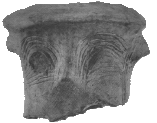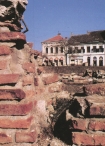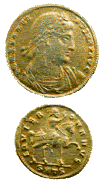|

Kalvarija
today

Ceramic
Vessel - Neolith
|
The modern town of Sremska
Mitrovica occupies the area formerly inhabited by
various pre historical peoples and cultures whose origin goes back to the
first occurrences of the organized human life in the region of Srem. The
archaeological research work, carried out through several years, allowed us
to fix clearly the continuity of life from the later part of the Stone Age
(Neolithic), through the Copper Age (eneolithic), the Bronze Age, the early
period of the Iron Age (Hallstatt) and the late period of the Iron Age (La
Tene) to the arrival of Romans, when Sremska Mitrovica enters the historical
epoch, i.e. the period of antiquity.
If we analyze the conditions which had determined the
settlement of pre historical populations in this territory, we should
mention, in the first place, the river Sava, along
which are situated pre historical localities of Kalvarija, Mala Strana and
Leget. The river offered the pre historical man the possibility supply
himself with food, by fishing; he used it, in addition, as a line of
communication – waterway – in order to achieve a direct contact with his
neighbors and to extend his horizons and his knowledge. It is also to be
remembered that the narrower and the wider hinterlands of Sremska Mitrovica
are formed of flat open country, very appropriate to the cereal growing and
to the development of other forms of agriculture.
In observing the movable archaeological materials from
the first appearance of earthen (ceramic) vases and iron axes, further of
weapons, tools and ornaments of copper, gold, bronze and iron to the
appearance of coins, we can follow the evolution of an environment which,
from the first semi-organized forms of community, reached a degree of
civilization approximating the forms of State. The ethnical protagonists of
pre historical cultures of Sremska Mitrovica are unknown, except for the late
Iron Age, whose representatives were the Celts who established the fortified
place – oppidum – in the locality of Kalvarija which developed later, when
the Romans arrived, into the ancient Sirmium.
Dragan POPOVIĆ
|
|


|
  Sirmium
entered the history in the course of the last decades of the old era, with
the arrival of Roman legions, but the founders of the town (civitas) were the
Pannonian Amantins and Celts, as inhabitants of the pre historical Sirmium.
As a Roman settlement, Sirmium developed very rapidly and in the period of
the Flavian dynasty (69 – 96 of our era) the town was granted the status of a
colony. Sirmium
entered the history in the course of the last decades of the old era, with
the arrival of Roman legions, but the founders of the town (civitas) were the
Pannonian Amantins and Celts, as inhabitants of the pre historical Sirmium.
As a Roman settlement, Sirmium developed very rapidly and in the period of
the Flavian dynasty (69 – 96 of our era) the town was granted the status of a
colony.
The important military needs at the susceptible
Danubian frontier have contributed to the importance of Sirmium where there
were frequently seats of headquarters of Roman troops. Several rulers,
such as Traian, Marcus Aurelius, Septimius Severus, Maximinus and Gallienus
visited Sirmium. The first rate importance of the town was confirmed by the
events the middle of the III century, when the »Illyrian caesars«, born in
Sirmium or in its surroundings (Decius Traian, Aurelian, Probus, Maximian
Herculius), came to the throne of the Roman empire.
The great Diocletian's reform made Sirmium, in 294, one of the capitals of
the Empire. In the course of the rapid evolution, the town changed several
times its town planning physiognomy and a military fortress in the beginning,
Sirmium was transformed into an opulent and luxurious imperial residence,
with the institutions accompanying the Roman administrative apparatus as well
as the economical, religious and cultural life.
Numerous monuments of Sirmium point out a multinational
population, composed of Romanized Illyrians and Celts and of immigrants
from Italy,
Greece, Gaul, Germany,
Syria and Africa. In Sirmium there were large workshops in which weapons,
glass, ornaments and metallic dishes and plates were manufactured. The Mint,
founded by Constantine the Great. developed an important activity, it struck
the famous gold bars with the figure of Fortuna, patron goddess of the town
of Sirmium. The archaeological excavations brought to light the rests of the
great Imperial palace, emperor Licinius's thermae, municipal granary,
fragments of monumental town walls and dozen of other edifices and constructive
details which corroborated the words of the ancient historian Amianus,
Marcellinus, who qualified Sirmium as »glorious and populous Mother of
towns."
Dr Petar MILOŠEVIĆ
|






